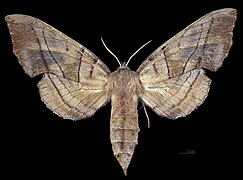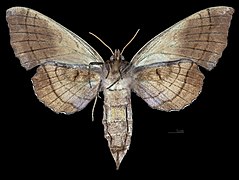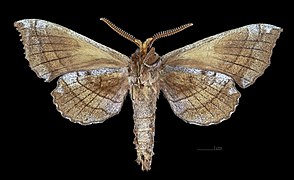Amorpha juglandis
| Walnut sphinx | |
|---|---|

| |
| Scientific classification | |
| Kingdom: | |
| Phylum: | |
| Class: | |
| Order: | |
| Family: | |
| Subfamily: | |
| Genus: | Amorpha Hübner, 1809
|
| Species: | A. juglandis
|
| Binomial name | |
| Amorpha juglandis (J. E. Smith, 1797)[1]
| |
| Synonyms | |
| |
Amorpha is a monotypic moth genus in the family Sphingidae erected by Jacob Hübner in 1809. Its only species, Amorpha juglandis, the walnut sphinx, was first described by James Edward Smith in 1797.
Distribution
It is native to North America, where it is distributed from the Atlantic Ocean to the Rocky Mountains in Canada and the United States.
Description
The wingspan is 45–75 mm.
-
Female
-
Female underside
-
Male
-
Male underside
Biology
The adult moth is nocturnal, active mainly during the early hours of the night.
The caterpillar feeds on alder (Alnus), hickory (Carya), hazelnut (Corylus), beech (Fagus), walnut (Juglans), and hop-hornbeam (Ostrya) species. When attacked by a bird, the caterpillar produces a high-pitched whistle by expelling air from pair of spiracles in its abdomen. This antipredator adaptation may startle the bird, which may then reject the caterpillar.[2]
References
- ^ "CATE Creating a Taxonomic eScience - Sphingidae". Cate-sphingidae.org. Retrieved 2011-11-01.[permanent dead link]
- ^ Fullard, James H.; Napoleone, Nadia (2001). "Diel flight periodicity and the evolution of auditory defences in the Macrolepidoptera". Animal Behaviour. 62 (2): 349. doi:10.1006/anbe.2001.1753.
Further reading
- Bura, V. L.; Rohwer, V. G.; Martin, P. R.; Yack, J. E. (2010). "Whistling in caterpillars (Amorpha juglandis, Bombycoidea): Sound-producing mechanism and function". Journal of Experimental Biology. 214 (Pt 1): 30–7. doi:10.1242/jeb.046805. PMID 21147966.
- Knight, K. (2010). "Whistling Caterpillars Startle Birds". Journal of Experimental Biology. 214 (Pt 14): ii. doi:10.1242/jeb.054155. PMID 21834205.
External links
- Lotts, Kelly; Naberhaus, Thomas (2017). "Walnut sphinx Amorpha juglandis (J.E. Smith, 1797)". Butterflies and Moths of North America. Retrieved December 11, 2018.
{{cite web}}: Unknown parameter|last-author-amp=ignored (|name-list-style=suggested) (help) - "Amorpha juglandis (J. E. Smith, 1797)". Sphingidae of the Americas. Archived June 29, 2006.
- Cotinis (December 19, 2012). "Genus Amorpha". BugGuide. Retrieved December 11, 2018.





